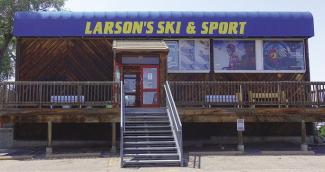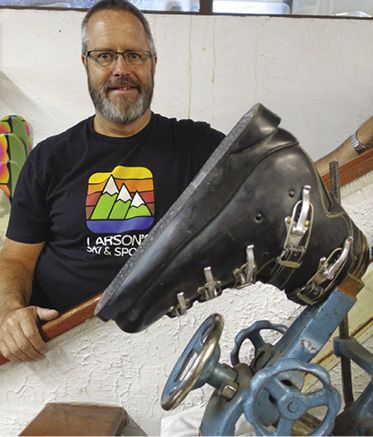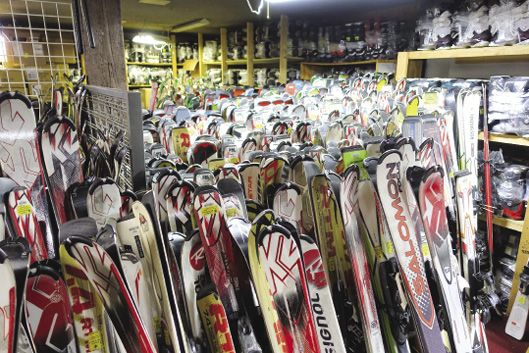Larson's Ski and Sport: Thriving 50 Years

The best location in the Denver area got this store off to a fast start.
Growing up in Idaho Springs, Colorado, long before I-70 came through and the Eisenhower Tunnel was bored, Duane Larson made skiing central to his life. In 1964, at age 16, he began working at a local ski shop, New R and D, and continued working there on weekends while attending the University of Colorado in Boulder. He also worked at Lange/Dynamic’s Broomfield factory, where he mastered the art of polishing the cracked edges of the VR17 skis made there.
After graduating in 1971, Larson went on to pursue careers in mining and human resources. But in June 1974 he happened to wander into the Alpina ski shop in Wheat Ridge, Colorado, just as the original owner was shutting it down. “The guy opened the shop in 1972 for his son to run, but the son had a bad cocaine habit, so the shop closed,” says Larson, now retired on Bainbridge Island, Washington.
Larson paid $9,000 for the shop equipment and took over the lease. He borrowed $19,000 from the bank and changed the signage. In the fall of 1974, at age 26, he opened Larson’s Ski and Sport.
The Eisenhower Tunnel on Interstate 70 was only a year old; Summit County and Vail were beginning to draw massive drive-to traffic from the Midwest. Larson’s was located two blocks from an easy-off, easy-on interchange on the I-70 freeway up to the mountain resorts. Larson couldn’t afford major media advertising, so he placed cheap ads, with $10 coupons for rental gear, in student newspapers at all the Big Eight universities. The store became a magnet for college students driving in from the Midwest. With the coupon they could get equipment for $4.25 per day ($28.22 in today’s dollars). “I knew the college newspaper ads were working; I had boxes of redeemed coupons,” says Larson.

By 1984, he decided to pursue other interests and sold his shop to John Marriott, a fellow Coloradan and enterprising employee of five years who, at 21, was still in college. Larson says proudly, “I may have serviced 150 seasonal rentals at the time. Now, John rents thousands of packages, often to the same former university students–now adults–and to their own kids and, in a few cases, their grandkids.” He continues, “John wanted to make a career out of ski retailing and was quintessentially the most loyal person you could find. He enjoyed a tight family support system at home. Since then, his business has blown up.”
For four decades under Marriott’s ownership, Larson’s has survived in a highly competitive business dominated by big-box stores and resort-owned chains. In 1991, Marriott moved the store into an old nightclub that he had purchased and renovated. It put him two blocks closer to the freeway—right at the bottom of the exit ramp.
Secret Sauce
It’s summer, and floor traffic is light when Skiing History visits. Walking inside the 10,000-square-foot location is like walking into a museum. Vintage skis and boots line the walls. There’s 10th Mountain Division equipment, Scott rear-entry boots with Spademan binding plates, Hanson Scorpion rear-entry boots with custom-molded wax bladders and, nearby, Henke, Humanic and Kastinger boots. Meanwhile, every square inch of remaining space is packed with new gear from dozens of leading ski-industry vendors, including top-five ski brands Dynastar, K2, Nordica, Rossignol and Völkl.
The secret sauce to Larson’s thriving $5.2 million annual business? “We believe that doing business with us should be easy,” says Marriott “We want to help make the sports we’re passionate about available to anyone and everyone who would like to participate. We follow common-sense business practices and believe in treating our customers the way we like to be treated when we’re customers.”
Marriott knows his market well. It’s not high-rollers who fly directly to Edwards, Hayden or Aspen but price-sensitive drive-in skiers. “We provide an antidote to the high cost of skiing, which, actually, doesn’t have to be that high,” he says.
Seasonal rental packages are $120 for kids; adult basic packages for Alpine or cross-country gear are $190, and an adult performance package is $240. Notes Marriott, “Skiers can get a $190 basic package from us, buy a couple of $269 4-Pak lift ticket deals at Loveland and ski for eight days a season for $730. Think about it. That’s about every other weekend.”
Larson’s also runs two ski swaps to help customers sell gear on consignment, further defraying their costs. Sellers receive either a 100 percent in-store credit that never expires or a check for 70 percent of the sales price.
Eight Thousand Packages
The staff knows that once seasonal-rental skis or snowboards leave the shop, starting September 1, they won’t see them again until July 15 at the latest, so they must go out in the best possible condition.
The quiet on the main floor last summer belies the activity downstairs in the repair shop as a team of associates, part of the store’s 16-person full-time summer staff (which balloons to 38 in winter), are preparing 8,000 ski and snowboard packages for the post–Labor Day rush.
Six shop technicians are working nonstop, using Wintersteiger belt sanders, stone grinders, edge grinders and a binding tester. The walls are lined with 80 binding jigs, some dating back to the 1970s, which are used when customers want to exhibit restored vintage pencil skis.
“Some renters will use their packages only four days a season,” explains Marriott. “Others will take them for 120 days on snow and everywhere in between. At $26 per day for packages, we’re easily 33 to 50 percent lower than the cost of renting on the hill.” He adds, “This attention to customer service and quality gear is the best way we can out-compete big-box and discount chain stores—they have a hard time putting it all together and staffing it.”
Working a Boot Until It Fits
Marriott believes Larson’s sells more boots than any single store location along the Front Range. Boot-fitters receive outside training from Masterfit University as well as through clinics run by the boot manufacturers. “We’ll work on a boot until it fits or give the customer a different boot,” he says.
If a customer comes back with boot issues, the store can make adjustments on the spot. For a fee, a staffer will adjust boots purchased elsewhere. This attention to boot-fitting is one reason adaptive athletes from the National Sports Center for the Disabled at Winter Park rely on Larson’s expertise.
Word of Mouth
“Our advertising is mostly word of mouth,” says Marriott. “If customers get the best possible service they’ve ever had, they’re going to tell friends.” He boosts the shop’s social media presence through Meta and Google ads, as well as with a series of instructional (and sometimes humorous) videos known as Ski School Sunday. Meanwhile, pro deals for ski-industry influencers help draw them into the store.

Larson’s also enjoys a robust online presence that accounts for 15 percent of annual sales. Shipping is free and usually goes out the same day. “We want people to have the same level of customer service whether they’re buying online from Chicago or walking in the door,” says Marriott.
His biggest worry about the local ski industry is overcrowding, not necessarily on the hill but on I-70. “Once skiers get to the mountain, thanks to improvements in uphill capacity, they’re pretty well dispersed,” he notes. “It’s getting to the mountains that I worry about. But even that is starting to level out thanks to remote work, flexible work schedules and more personal time off.” These factors spread skier traffic across the week, reducing the weekend crush.
Looking to the future, Marriott says, “I’ve been successful enough that I could retire now if I wanted to, but every day I get up, I want to be here with this crew of skiers and snowboarders, be around our customers and interact with all my colleagues in the ski world. A visit to Larson’s should potentially be the best part of everyone’s week.” 
Jeff Blumenfeld, a resident of Boulder, Colorado, is vice president of ISHA and immediate past president of the North American Snowsports Journalists Association (NASJA.org). As a fellow of the Explorers Club for 35 years, he’s covered the exploration and adventure field in ExpeditionNews.com.